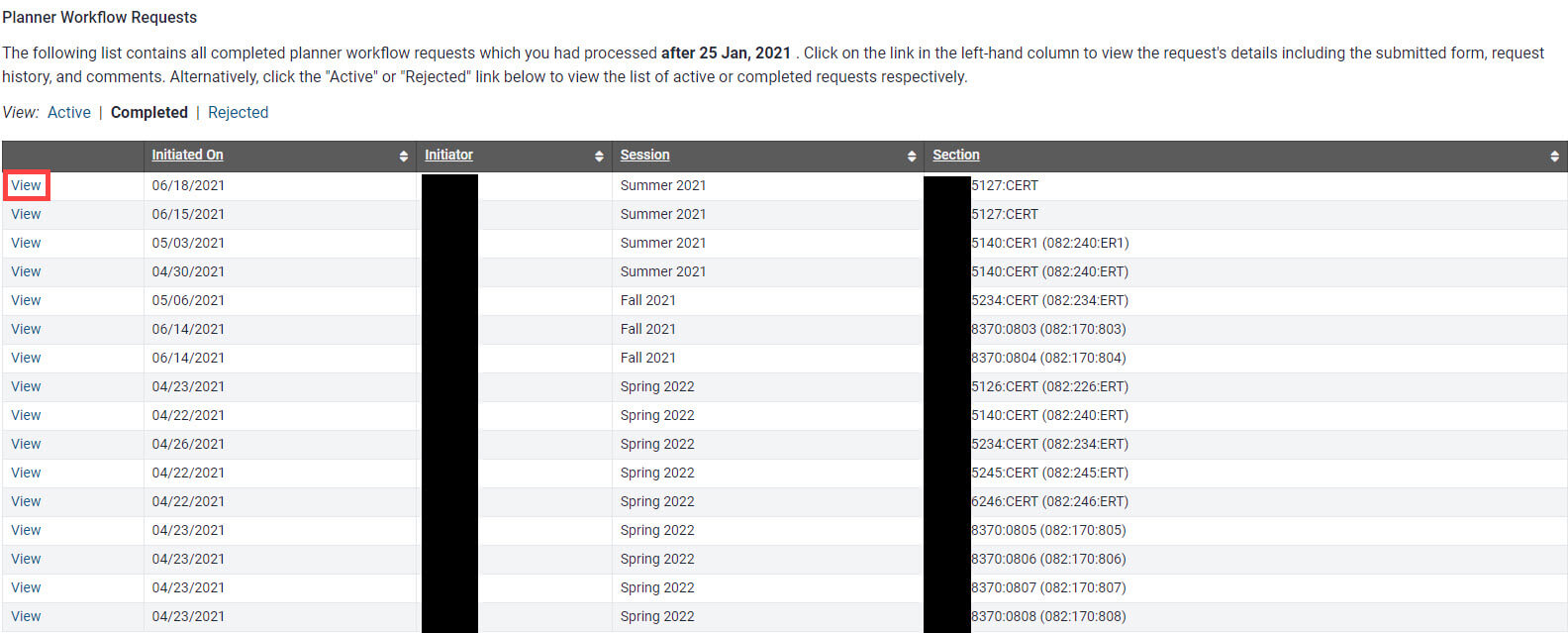When course sections are submitted through workflow for initial approval, and when course section change requests are made, it is possible for administrators to view where a workflow is in the approval process. Active, Completed, and Rejected requests are viewable, as well as comments posted to the workflow by the Office of the Registrar.
Utilizing Planner Workflow to review Active course requests can be particularly helpful if you're trying to expedite a section through the approval process. Or, if you've submitted a request and realize a change needs to be made, you can look to see who currently has the workflow, and you can contact that person to request the workflow be returned to you.
How to Review Planner Workflows
1. On the Registrar Tab click Planner Workflow

2. On Active view you will see any outstanding requests you've submitted

3. On Completed view you will see all workflows which have been completed
Clicking View next to a given Section will provide more information about the workflow submitted.

4. On Rejected view you will see all workflow requests that were not approved
Clicking View next to a section will provide more information, including a workflow note explaining why the workflow was not approved.

Sections Rejected/Returned to Departments
The Office of the Registrar reviews critical elements of course sections when they are submitted for approval. If there are issues with information as submitted, Office of the Registrar staff will reject/return the section to the department. The workflow will include a comment explaining why the section was returned and what needs to be done to fix the information.
The following list explains reasons why a section workflow would be rejected/returned. Please click the down arrow next to each topic for further information.
Initial Section Submission (Sections in "Planning" status)
Contact Hours Not Met
When a section is submitted with a set meeting pattern (time/location) the amount of time indicated must equal the minimum amount of time required to fulfill the credit hours listed for the course section. If the amount of time is not adequate, the course section will be returned for updates.
50 minutes, one day a week for 15 weeks = 1 semester hour of credit. The following resources are available to help determine if contact minutes have been met.
Time/Location information does not follow the Approved Class Time Model for courses requesting University Classrooms
The primary goal of the Office of the Registrar is to maximize courses, staff, and teaching spaces while reducing operating costs to be fiscally efficient and environmentally responsible.
In order to achieve these goals, revised scheduling policies and procedures have been established by Classroom Scheduling and approved by The Office of the Provost. The scheduling regulations apply to those colleges who utilize university classrooms from the Colleges of Liberal Arts and Sciences, Education, and Engineering, and Tippie College of Business.
Related Sections (Lecture/Lab/Discussion) not submitted together
In order for the Office of the Registrar to verify related section courses are set up correctly and meet requirements, it's imperative that departments submit all related sections together. If they are not submitted together, sections will be returned to the department until all related sections can be submitted as a group.
MyUI Course, Section, Registration Info incorrect/absent
Use of MyUI course, section, and registration information is optional. When these areas are utilized, the Office of the Registrar reviews the information to ensure it accurately reflects the information submitted for the section.
If the information is not consistent, sections will be returned to the department for correction
Information in the MyUI course, section, and registration information areas does replicate. It is important for departments to review the text and make edits if needed prior to submitting sections through workflow.
Delivery Mode does not match Management Type
Section Number for Online Course does not include "EX"
One Day a Week Courses Greater than 120 Minutes or Two Contact Hours
Standard class times will be strictly adhered to when the course is open to undergraduate enrollment in university classrooms (graduate sections are exempt). However, in some cases, a desire to schedule a single day of the week that extends beyond 120 minutes exists. In order to do so, the course requires justification from the Department Chair to be e-mailed to renee-houser@uiowa.edu, who will route the e-mail to the Associate Provost for Undergraduate Education for review. Further, these courses must be scheduled on the Monday/Wednesday/Friday standardized meeting pattern and paired in some manner with an alternate course(s) to fulfill the three-day meeting pattern and eliminating classroom inefficiency during prime time. One day a week classes scheduled at 5:30 p.m. or later on Monday, Wednesday, or Friday; or at 5:00 p.m. or later on Tuesday or Thursday; do not require pairing. Currently, film screening section types are exempt from this rule and require no prior approval; however, course pairing is still encouraged to eliminate inefficiencies that film screenings may create.
Sections requesting Updates/Revisions ("Approved" Planner status)
Requesting large classroom in comparison to Opt Enrollment without justification
Requesting time/location change too close to start of session
The following course offerings scheduling policy applies to all regular (on-cycle & off-cycle) sections assigned to University Classrooms (UCR) and all undergraduate courses, numbered 0000–4999, whether or not scheduled in UCR spaces. Changes in the location, start and end time, or start and end date can be loaded on MyUI up until the deadline date of January 1 for Spring offerings and August 1 for Fall offerings. After the offerings deadline date, course scheduling changes will only be approved with sufficient justification provided on the workflow request. The only justifications for a change in the location, start and end time, or start and end date for a course are an extreme emergency involving an instructor (death or disability) or a desire for a larger room to accommodate more students. As always, departments are responsible for student notification of any changes.
Additional Information about Planner Workflow
